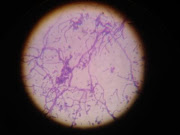Research Completed entitled "FACTORS
LIMITING THE UTILIZATION OF PRIMAQUINE FOR RADICAL TREATMENT OF VIVAX MALARIA
IN FAR WESTERN REGION OF NEPAL"
funded by
Ministry of Education, Science and Technology, Singhadurbar, Kathmandu
Research Team:
Nabaraj Adhikari, Prakash Ghimire, Megha Raj banjara, Komal Raj Rijal and Upendra Thapa Shrestha
SUMMARY
Backround: Plasmodium
vivax malaria remains an important public health problem in
many parts of the world. The World Health Organization (WHO) estimates that P.
vivax was responsible for 8.5 million cases of malaria globally in 2015. Malaria
remains a priority public health problem in Nepal, where approximately 50% of
the population is at risk of malaria and the threat of an outbreak is still
real primarily as a result of receptivity and vulnerability characteristics of
the country. The trend of malaria during the last decade indicates that
substantial progress has been made towards elimination in Nepal. All districts
now have an API less than 1/1000 and the country is moving towards “vision of
malaria free Nepal by 2025”. An
essential element to achieving the elimination of malaria will be killing both
the blood and liver stages of the parasite. Primaquine (PQ), an
8-amnoquinoline, is the only licensed drug that effectively kills P. vivax hypnozoites. While it is well
tolerated in the majority of recipients, primaquine and related compounds can
cause severe side effects (haemolysis) in individuals with the inherited
enzymopathy glucose-6-phosphate dehydrogenase (G6PD) deficiency. Prioritization of radical cure for P. vivax malaria
has become better recognized recently, along with malaria elimination. Though
the national malaria treatment protocol has lucidly states the use of
primaquine for the treatment of vivax malaria after screening of G6PD status of
the patient, many health care personnels are reluctant to use this drug in
endemic districts of the country.
Aim: This study has been designed
to explore the factors limiting utilization of primaquine for the management of
vivax malaria in far western region of Nepal. In addition, the patient’s
perspective in the provided treatment, limitations in laboratory facilities
will also be explored during the study period.
Study sites: Mahakali Zonal Hospital
Kanchanpur, Malkheti and Tikapur Hospital of Kailai district.
Study Population: The study
population were the malaria patients (infected with vivax malaria) and drug prescribers
(physicians, health assistants and nurses).
Sample size: Altogether 125 (75
malaria patients and 50 drug prescribers) individuals were enrolled in the
study.
Study tools: A semi structured
questionnaire was developed for interview of the patients and the drug
prescribers. In addition to individual questionnaire, a focus group discussion
of drug prescribers was also conducted as part of qualitative research.
Results: during the course of study
majority of the patents were Dalits (56%). Around three-fourth of the patients
were male and most of the patients were in the age group of 16-45 years.
Maximum patients had their job in India (37.3%) and higher number of patients
had formal primary level education (42.6%). About 78.7% of the patients had
heard about malaria and 56% had knowledge about the transmission of malaria.
However, only 20% of the patients had knowledge regarding the signs and
symptoms of malaria. About 50.7% of the patients were aware about the
preventive measures of malaria. Only 33.3% of the patients had known that the
diagnosis and treatment of malaria is free in the government health facilities
of Nepal. Majority of the patients (50.7%) had come to the health care
facilities 3 or more days after the onset of fever. In addition, 36% of the
patients visited repeatedly in the health care facilities in the last 3 months.
Only 33.3% of the patients were found sure that the malaria can be cured by
antimalarial drugs. About 34.7% of the patients did not understand the
counseling by drug prescribers on how to take the antimalarial drugs. About 36%
of the patients reported that there is no need of taking the drugs after the
fever subsides. About 84% of the patients reported that they were not advised
by the drug prescribers for follow up. About 40% of the drug prescribers had
experience in the field of malaria for 10 or more than 10 years. About 92% of
the drug prescribers believed vivax malaria as the problem in their catchment
area. About 84% of the drug prescribers had told that they follow the new
malaria treatment guidelines 2015. However only 40% of the drug prescribers
have received training on new treatment guidelines. About 80% of the drug
prescribers had reported that they use to treat vivax malaria with 14 days
primaquine therapy. About 82% of the drug prescribers use to review the result
of G6PD test before administration of 14 days primaquine to the patient. No one
of the drug prescriber had ever noticed the adverse effects after primaquine
treatment.
Conclusion: The study finds some
gaps between the patients and drug prescribers for the effective management of
vivax malaria in the study sites.
Recommendation: The
stakeholders must address and hit in those gaps for the timely elimination of
malaria from Nepal.






















2 comments:
Hey, thегe and Thank you so much for sharing this information. It has very useful. Please keep sharing. If you want more about the best treatment for malaria Kindly click the link
malaria hospital in Coimbatore
Great insights, very well explained and clear.
Iv hydration in Murrieta
Post a Comment